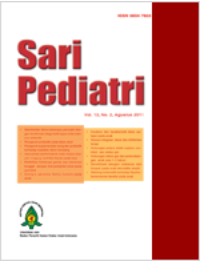Respons Awal Obat Antiepilepsi Monoterapi pada Pasien Epilepsi Baru
Sari
Latar belakang. Epilepsi merupakan satu dari penyakit neurologi yang sering menyebabkan disabilitas dan kematian. Prediktor terbaik dalam menentukan remisi epilepsi adalah respons awal terhadap OAE. Terdapat beberapa faktor yang memengaruhi respons awal terapi diantaranya etiologi epilepsi, jumlah kejang sebelum pengobatan, bentuk bangkitan kejang, status neurologi, usia awitan dan gambaran elektroensefalografi.
Tujuan. Mengetahui faktor-faktor yang memengaruhi respons awal OAE pada pasien epilepsi baru pertama kali.
Metode. Penelitian merupakan penelitian kohort prospektif dengan melihat respons awal OAE pada anak penderita epilepsi baru selama 3 bulan yang berobat ke poliklinik rawat jalan RSUP dr Cipto Mangunkusumo sejak Januari 2017 sampai Agustus 2017. Faktor-faktor risiko dianalisis secara bivariat dan multivariat.
Hasil. Insiden epilepsi baru adalah 21,9%. Karakteristik pasien epilepsi baru yang mendapat OAE monoterapi sebagian besar berumur ≥1 tahun. Etiologi struktural, awitan kejang ≥1 tahun, jumlah kejang sebelum pengobatan ≥10 ditemukan lebih banyak. Pasien epilepsi tanpa kelainan neurologi ditemukan lebih sedikit dibanding dengan kelainan neurologi. Sebagian besar pasien adalah dengan bangkitan kejang umum dan dengan gambaran kelainan EEG. Respons awal yang baik pada pasien epilepsi baru terhadap OAE monoterapi adalah 77,2% dalam 3 bulan pengobatan. Faktor yang berhubungan dengan respon awal baik adalah etiologi epilepsi, jumlah kejang, kelainan neurologi, bangkitan kejang, dan gambaran EEG. Sementara faktor risiko respons awal dalam 3 bulan pemberian OAE monoterapi adalah jumlah kejang dan gambaran EEG.
Kesimpulan. Faktor yang berperan terhadap respons awal terapi OAE monoterapi adalah jumlah kejang dan gambaran EEG.
Â
Kata Kunci
Teks Lengkap:
PDFReferensi
Kwan P, Brodie MJ. Early identification of refractory epilepsy. N Engl J Med 2000;342:314-9.
Dwi Putro W. Faktor risiko terjadinya epilepsi yang sukar disembuhkan pada anak dibawah umur 5 tahun: pengembangan sistem skoring untuk memprediksi secara dini (disertasi). Jakarta : Universitas Indonesia. Program Studi S3 Kedokteran,2012.
Geerts AT, Arts WFM, Brouwer OF, dkk. Validation of two prognostic models predicting outcome at two years after diagnosis in a new cohort of children with epilepsy: The dutch study of epilepsy in childhood. Epilepsia 2006;47: 960-5.
Geerts A, Arts WF, Stroink H, dkk. Course and outcome of childhood epilepsy: A 15-year follow-up of the Dutch Study of Epilepsy in Childhood. Epilepsia 2010;51:1189-97.
Arts WFM, Brouwer OF, Peters ACB, dkk. Course and prognosis of childhood epilepsy: 5-year follow-up of The Dutch study of epilepsy in childhood. Brain 2004;127:1774-84.
Scheffer IE . ILAE classification of the epilepsies:vposition paper of the ILAE commission for classification and terminologi. Epilepsia 2017;1:1-10.
Dragoumi P, Tzetzi O, Vargiami E, Pavlou E, Krikons K, Kontopoulos E. Clinical course and seizure outcome of idiopathic childhood epilepsy: determinants of early and long-term prognosis. BMC Neurology 2013;13:206-18.
Kwan P, Brodie MJ. Effectiveness of first antiepileptic drug. Epilepsia 2001;10: 2:1255-60.
McHugh JC, Delanty N. Epidemiology and classification of epilepsy: gender comparisons. Int Rev Neurobiol 2008;83:11-25.
Park KM dkk. Initial response to antiepileptic drugs in patients with newly diagnosed epilepsy. J Clin Neurosci 2014;21:923-6.
Casetta I, Granieri E, Monetti V, dkk. Early predictors of intractability in childhood epilepsy: a community-based case-control study in Copparo, Italy. Acta Neurol Scand 1999;99:329-33.
Wirrell E, Wong-Kisiel L, Mandrekor J. Nickels K. Predictor and course of medically intractable epilepsy in young children presenting before 36 month of age: A retrospective, population-based study. Epilepsia 2012;53:1563-9.
Mangunatmadja I. Prediksi luaran klinis pasien epilepsi fokal berusia kurang dari 3 tahun: Peran evolusi klinis dan elektroensefalografi serta magnetic resonance imaging. (disertasi). Jakarta: Fakultas Kedokteran Universitas Indonesia, Program Studi Doktor Ilmu Kedokteran, 2012.
Anon. Epilepsy fact sheet. World Health Organization media centre web page. Februari 2015. Diakses 1 oktober 2015. Didapat dari : http://www.who.int/mediacentre/factsheets/fs999/en/
Panayiotopoulos CP. Principles of therapy in the epilepsy. Dalam : A clinical guide to epileptic syndromes and their treatment. Edisi kedua. London: Springer Healthcare;2010.h.173-93.
Berg AT, Shinnar S, Levy SR, Testa FM, Smith-Rapaport S, Beckerman B. Early development of intractable epilepsy in children: a prospective study. Neurology. 2001;56:1445-52.
Camfield PA, Camfield CS, Gordon K, Dooley JJ. If a first antiepileptic drug fails to control a child’s epilepsy, what are the chances of success with the new drug ? J Pediatr 1997;131:821-4.
Zhang Y, Yu N, Su L, Di Q. A prospective cohort study of prognosis for newly diagnosed epilepsy in east China. BMC Neurol 2013;13:1-8.
Mohanraj R, Brodie MJ. Diagnosing refractory epilepsy : response to sequential treatment schedules. Eur JNeurol.2006;13:277-82.
MacDonald BK, Johnson AL, Goodridge M, Cookerell OC, Sander JWAS, Shorvon SD. Factor predicting prognosis of epilepsy after presentation with seizures. Ann Neurol 2000;48:833-41.
Abimbola S, Martiniuk ALD, Hackett ML, Mohamed A, Anderson CS. Early predictor of remission in newly diagnosed epilepsy: a systemic approach to reviewing prognostic factor studies. Neurological Research. 2014;36:1-12.
Sillanpaa M, Schmidt D. Delayed time to first remission identifies poor long-term drug response of childhood-onset epilepsy:A prospective population-based study. Epilepsy Behavior 2009;16:507-11.
Ramzi, Soenarto Y, Hapsari S, Hakimi M. Prognostik factor of refractory epilepsy in children. Paediatr Indones 2008;48:269-72.
Panayiotopoulos CP. EEG and brain imaging. Dalam : A clinical guide to epileptic syndromes and their treatment. Edisi kedua. London : Springer Healthcare Ltd; 2010.h.147-69.
DOI: http://dx.doi.org/10.14238/sp22.5.2021.270-6
Refbacks
- Saat ini tidak ada refbacks.
##submission.copyrightStatement##
##submission.license.cc.by-nc-sa4.footer##
Email: editorial [at] saripediatri.org


Sari Pediatri diterbitkan oleh Badan Penerbit Ikatan Dokter Anak Indonesia
Ciptaan disebarluaskan di bawah Lisensi Creative Commons Atribusi-NonKomersial-BerbagiSerupa 4.0 Internasional.




